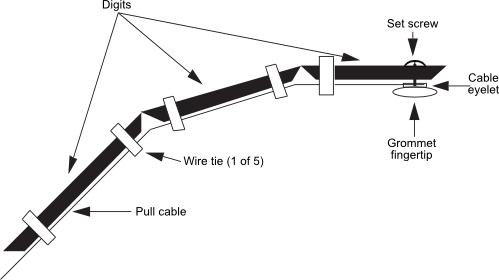Flexible Finger Grippers
Most gripper designs lack is a compliant grip: the capacity to contour the grasp to match the object. The digits in our fingers can wrap around just about any oddly shaped object, which is one of the reasons we are able to use tools successfully.
You can approximate the compliant grip by making articulated fingers for your robot. You can make your own fingers from a variety of flexible materials. One approach is to use the plastic pieces from some of the toy construction kits. Cut notches into the plastic to make the joints. Attach a length of 20- or 22-gauge stove wire to the fingertip and keep it pressed against the finger using nylon wire ties. Do not make the ties too tight, or the wire won’t be able to move. An experimental plastic finger is shown below.

You can mount three or four such fingers on a plastic or metal “palm” and connect all the cables from the fingers to a central pull rod. The pull rod is activated by a solenoid or motor. Note that it takes a considerable pull to close the fingers, so the activating solenoid or motor should be fairly powerful.
The finger opens again when the wire is pushed back out as well as by the natural spring action of the plastic. This springiness may not last forever, and it may vary if you use other materials. One way to guarantee that the fingers open is to attach an expansion spring, or a strip of flexible spring metal, to the tip and base of the finger, on the back side. The spring should give under the inward force of the solenoid or motor, but adequately return the finger to the open position when power is cut.